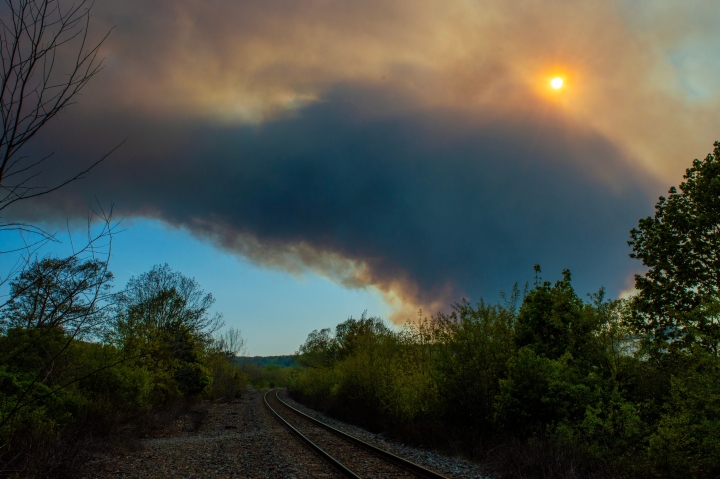Smoke from hundreds of wildfires in eastern Canada shrouded the Northeast and Midwest in a dense ochre haze this month, and more smoke could return to both regions of the United States this week as the conflagrations continue.
Dartmouth professors Justin Mankin and Laura Paulin weighed in on what the wildfires in Canada and their historic encroachment into major population centers indicate for a future shaped by climate change—and how we should prepare for it.
One driver of the extensive media coverage of the Canada wildfires was that large-scale blazes are much more common in western North America than on the wetter, greener Atlantic Seaboard. But these latest burns revealed that global warming can enhance wildfire risk no matter where you are, said Mankin, an assistant professor of geography and co-lead of the NOAA Drought Task Force.
Unlike wildfires in the West that result from long-term aridity, fire conditions in Canada developed relatively quickly from an unlucky period of below-average precipitation combined with far higher-than-average spring temperatures likely attributable in part to global warming, Mankin said. A month of below-average precipitation would not necessarily lead to widespread fire, but elevated temperatures accelerated drought conditions in only a few weeks, he said.
“Intense wildfire seasons occur when it is hot and dry, and this event is no exception. A high-pressure system parked itself over Canada in May and, just like a boulder disrupts the flow in a stream, this system steered rainstorms away from the country,” Mankin said. “A decline in precipitation from this pressure anomaly combined with exceptionally warm spring temperatures was enough to dry forests. Then all you needed was ignition and favorable winds.”
While we do not know precisely how much global warming increased the likelihood of this particular event, Mankin said, a warming climate does make it more likely that it will be hot anytime it happens to be dry, casting the die in favor of wildfires.
Unfortunately, the tipping point for wildfire in eastern North America is not well known given the lower intensity of wildfires compared to the West. Scientists do not have a great sense of how sensitive wildfire is to temperature versus precipitation changes in eastern North America, nor how this sensitivity is shaped by decades of fire suppression practices and declines in ecosystem health due to pests and tree disease, Mankin said.
“The implications with climate change are that places we think of as having wet climates, such as eastern Canada, can have an increased temperature sensitivity to wildfire,” Mankin said. “Though we think of wildfire as a risk primarily in western North America, this event indicates that no place is immune—especially when we include the widespread ancillary impacts such as wildfire smoke and the untold—and unregulated—public-health burden it represents.”
Paulin, an assistant professor of medicine and of epidemiology at the Geisel School of Medicine and a pulmonologist at Dartmouth Hitchcock Medical Center, said that concern over exposure to this month’s thick smoke—comprised mostly of particulate-matter air pollution—highlighted what will likely be a more common as climate change not only likely results in more wildfires, but also diminished air quality due to heat, humidity, and ozone.
The air quality in New York City on June 7 was the lowest of any major city in the world and the worst in the city’s history. Smoke from continuing wildfires in Canada caused air quality to reach unhealthy levels in the Upper Midwest late last week, with Saint Paul, Minn., having the nation’s worst air quality June 14, according to the federal government’s air-quality monitoring site, AirNow.
“We anticipate that these events are going to be happening more frequently and it’s a good time for people to learn what they can do and what the health effects are. People should not think of this as a one-and-done thing, but they should be asking themselves, ‘what do I do when this happens again,” Paulin said.
“We are exposed to a lot of air pollution that you can’t see and there should always be some level of concern,” she said. “ Major events like these bring more exposure to air quality, but giving people the tools to know where to get that information every day is important.”
People should familiarize themselves with public-health tools such as the air quality index and be aware of their own limitations and the seriousness of breathing in smoke. There may be a temptation to proceed with life as normal, but the small airborne particulates found in smoke can cause respiratory distress and are associated with short- and long-term heart and lung disease.
“Individuals may want to consider avoiding exercise during events like we just experienced. When we exercise, we’re breathing heavier and more through the mouth, bypassing the nose’s natural defenses and inhaling a larger particle load,” Paulin said.
“And if we as health care professionals are recommending people don’t go outside, it’s important to be cognizant of what people are doing indoors in terms of creating more particle load,” she said. “We recommend people stay inside and don’t smoke or burn anything in the house such as candles and wood.”
One factor that would enhance public preparedness is if the effects of climate change and extreme weather events were more regularly part of the curriculum and training for doctors and health care professionals, Paulin said.
“Things are changing and people are learning more about climate change and air pollution in medical school, but there’s still a lot of opportunity to teach health care professionals about counseling patients during these events and recognizing the symptoms of exposure to them,” she said.
“I don’t think we’re completely prepared for that now,” Paulin said. “We’re talking about it right now, but it takes one of these events to get people aware.”

